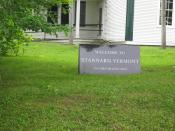"American Holocaust" by David E Stannard was first published and distributed in 1992, the same year that celebrated the quincentenary of the discovery of America by Christopher Columbus. The release date would not have been decided upon by happenchance, but would have been part of a well thought out marketing strategy to take best advantage of the five hundredth anniversary of American 'civilisation'. The book is highly controversial in its choice of theme, in that it shows the American people of the time as a barbarous, murdering race, which, at its zenith of policy making, instigated a deliberate tactic of extermination and genocide against the native Indian tribes by the leaders of the new United States, such as Thomas Jefferson and Andrew Jackson. Americans of today are taught to revere the leaders of the past, to elevate their memories to almost mythical status, to see them not as mortal men but as nearing the level of demi-gods.
For someone to portray their iconic figures of this time in any other way than civilised and beneficent, for a large percentage of the modern day United States, would be as a minimum seen as disrespectful to their memory and for the majority would be seen as bordering on blasphemous and seditious dissertation. It is also shown in this book that the everyday common folk in eighteenth and nineteenth century America, although not necessarily direct advocates of a genocide policy, allowed it to happen, either with the excuse of the soldier when following orders of the slaughter of natives or by the malaise of the man in the street that is seen as guilty by his own inaction. This also would not have pleased 1990s Americans, being told that their direct ancestors were as guilty as the perpetrators of these heinous...


